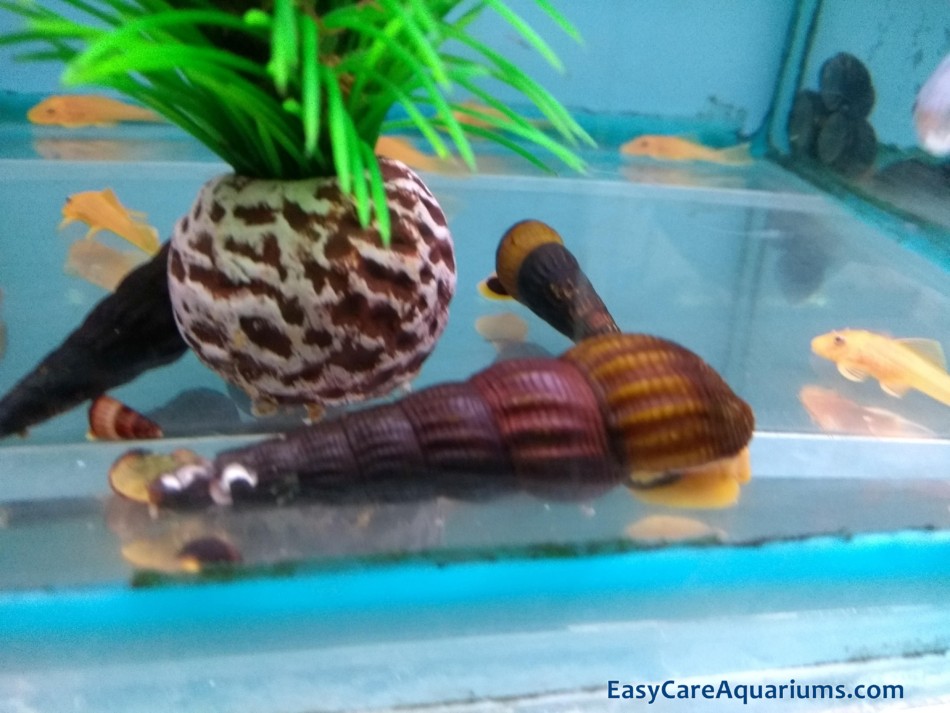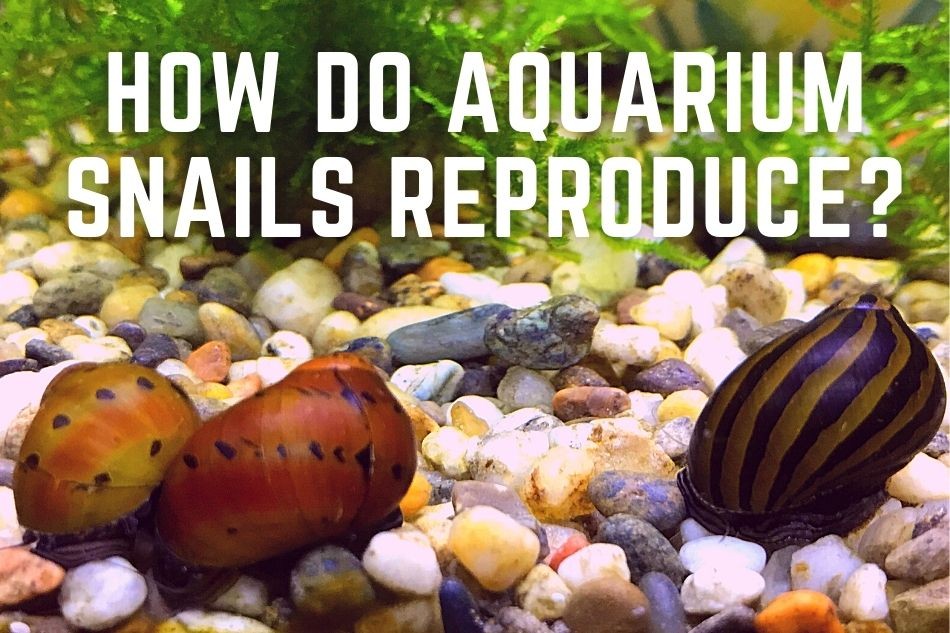This article may contain some affiliate links to products. The links provide me a small percentage of commission but do not cost you anything extra to use. (See full disclosure statement here ).
).
Some aquarium snails have a reputation for being prolific breeders. So if you’re thinking of introducing snails to your community tank you’ll need to be mindful of which types can end up reproducing at such a rate that they end up taking over.
Some types of aquarium snail can reproduce asexually, while others require a male & female pairing. Aquatic snails can also vary from livebearers to egg layers. In a freshwater tank some types of snail may lay eggs which will never hatch because they need a brackish water environment to develop in.
There are a variety of aquarium snails that will happily live in a freshwater habitat. Knowing how they reproduce can help you to choose which ones are best suited for your particular community aquarium.
Which Aquarium Snails Reproduce Asexually?
Malaysian Trumpet Snails
This type of snail can reproduce in 2 ways. While they are either male or female it’s not unusual for the female to reproduce asexually. Female Malaysian Trumpet Snails can reproduce clones of themselves. In fact, some aquarists believe that sexual reproduction between a male and female Malaysian Trumpet Snail is actually quite rare.
Malaysian Trumpet Snails are livebearers and will produce about one new offspring per month. Which means it can be quite easy to find yourself with an overpopulation problem unless you monitor the population and take measures to control it.
Ramshorn Snails
Ramshorn snails are hermaphrodites so have both male and female sexual organs. This type of snail doesn’t need a partner, they will reproduce asexually.
They will start breeding at about 1.5 to 2 months old.
When reproducing they will lay a jelly-like mass of roughly 10-12 eggs under the water. You’re most likely to find them on plants or the glass sides of your aquarium.
The eggs take approximately 10-20 days to hatch but this will depend on the temperature of your aquarium. Warmer water tends to speed things up. Once hatched the snails will set off to find food in the form of any soft algae that is naturally growing in your tank.
As you may have gathered, with the amount of eggs being laid it’s quite easy to become overrun by the Ramshorn Snail. So if you want to control the population then identifying the egg cluster quickly will enable you to remove them before they hatch.
Which Aquarium Snails Aren’t Asexual?
Apple Snails / Mystery Snails
There are several different types of Apple Snails, some of the more common are:
- Mystery Snails (Almost all mystery snails are apple snails)
- Golden Apple Snail
- Zebra Apple Snail
- Spike-Topped Apple Snail
- Giant Ramshorn Snail
Snails that come under the umbrella of Apple Snails breed in the same way.
These snails are hermaphrodites which means that each one is both male and female and has both sets of reproductive organs. But it still takes two snails for the breeding process.
Apple snails can be slow to reproduce but when they do they lay lots of eggs at a time. So it’s quite easy to end up with a population explosion in your aquarium.
They can lay between 200 – 600 eggs in one go and can lay several batches per month. The eggs are laid above the water level in order to keep them out of harm’s way.
The eggs hatch in approximately 2-3 weeks given the right conditions. The right conditions for the eggs to successfully hatch is a humid, but not a wet, environment. If the eggs aren’t kept in the right climate they will die.
If you don’t want extra Apple Snails in your community tank then keep an eye out for the eggs being laid and remove them from the tank before they hatch. Also, as two of this type of snail are needed to breed you could just choose to have only one as part of your set-up.

Rabbit Snails
Rabbit Snails are not hermaphroditic. They are either male or female and the male will provide sperm to the female and her eggs will be fertilized and laid when she’s ready.
These snails are slow to spawn but you can still end up with a population problem if you don’t control it. Even though a single egg, usually containing a single embryo is laid every 4-6 weeks, this can soon add up to a few extra occupants in your aquarium over the course of the year.
The egg is just smaller than a pea and you will often find these laid on, or in, the substrate. There is a short time between the laying of the egg and the newborn snail hatching. A lot of snail keepers say the time can be a short as half an hour. So if you don’t want to have additional Rabbit Snails in your tank then you can remove the eggs before they hatch. But you’ll need to be quick!
Alternatively, as it takes two snails of the opposite sex to reproduce, you could always just buy one of these and keep another type of snail as well because snails don’t interbreed.
If you want to learn more about Rabbit Snails click here to read another article that I wrote.
to read another article that I wrote.
Assassin Snails
Aquarists often purchase Assassin Snails in order to eliminate a population explosion of other types of snails. As the name suggests, it will kill and eat other smaller snails.
Assassin Snails are either male or female and need both sexes to breed successfully,
Compared to some of the other types of snail they are quite slow breeders. Which is good news as it makes them less likely to overrun your tank.
The female will lay eggs one at a time. But they will be laid in small groups on the hard surfaces of your tank. The eggs will take roughly 2 months to hatch.
As I mentioned before, Assassin Snails are slow breeders so shouldn’t overrun the aquarium unlike some other types of snail can. But if you don’t want, or need, any extra Assassin Snails roaming about it’s best to take care of the potential surplus population at the egg stage. Because once they’ve hatched they tend to bury themselves in the substrate and can be extremely difficult to find.

Which Aquarium Snails Don’t Reproduce In Freshwater
Nerite Snails
There are several types of nerite snails, some of the more commonly used varieties in the aquarium hobby are:
- Zebra Nerite
- Onion Nerite
- Tiger Nerite
- Horned Nerite
- Red Racer Nerite
Nerite snails do not reproduce asexually, they have Male or Female reproductive organs. As with most snails, it can be hard to tell unless you have a few hours spare to study them carefully.
Nerite snails don’t reproduce successfully in freshwater. The eggs need brackish (slightly salty) water to hatch in. The females do however have a tendency to lay loads of eggs on the hard surfaces of your tank. This can be a bit unsightly and the eggs can be quite difficult to remove depending on where the eggs are laid.
If you want any of the nerite snails as part of your clean up crew, but don’t want the hassle of dealing with clearing up the eggs, then it’s best to stick with the male of the species.
As I mentioned before it can be hard to tell the males and females apart. So if you really don’t want to deal with the eggs you could always quarantine them separately for a few weeks after purchase. Then watch to see if any eggs are laid. If it turns out you have a female ask your seller if they will take it back to sell on.
I have several Nerite Snails, some of which are obviously female because I get quite a few eggs laid in my tanks. I remove the eggs as best I can but to be honest the eggs don’t bother me. I’m more impressed with the way that my Nerites solved my hair algae problem and continue to keep the algae under control in my tanks.
Nerite Snails are ideal for beginners because they are easy going and don’t need any special treatment. They’re also fun to watch to as they go about the aquarium eating algae and cleaning up any leftover food and decaying plant leaves. Learn more about how snails can help clean your tank here .
.
Devil Spike Snails (Faunus ater)
Devil Spike Snails, also known as Faunus ater, need a male/female pairing to reproduce.
This type of snail is similar in look to the Rabbit and Malaysian Trumpet Snails. But that’s where the similarity ends. Unfortunately, there is little known about this type of snail. Although, just like the Nerite snail, the Devil Spike Snail won’t reproduce in freshwater because its young need brackish water.
As they are largely unknown, and difficult to breed, they seem to be quite hard to get hold of. Which is a shame as they appear to have all the benefits for an aquarium set up that the Rabbit or Malaysian Trumpet snails do. And without the hassle of over-populating the tank.
Do Aquarium Snails Die After Laying Eggs?
Snails don’t usually die as a result of laying eggs or other methods of reproduction. As we’ve seen, some snails are known for breeding more prolifically then others. But they will happily go on to produce more and more offspring unless you take measures to control them.
If a snail dies shortly after laying eggs, or giving birth to live young, it will usually be due to another cause. Such as a problem with the water quality, disease or just old age.

